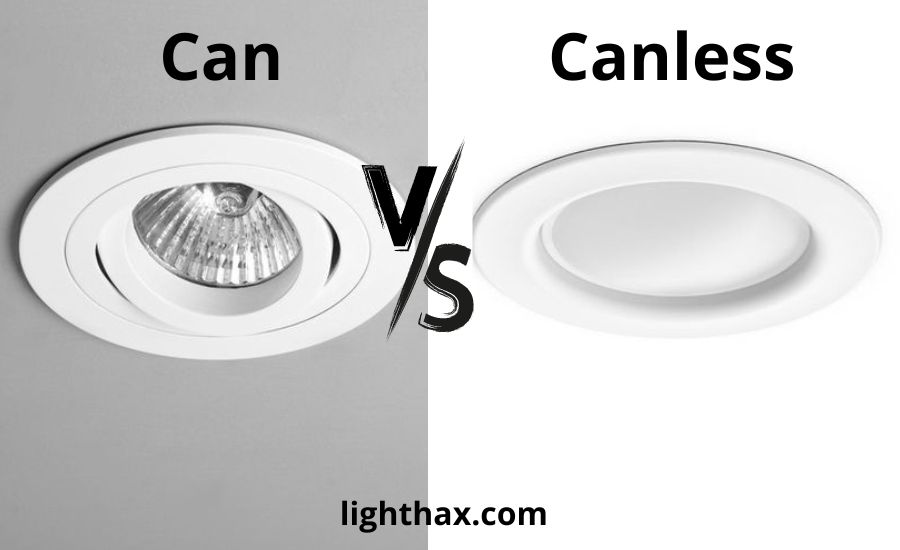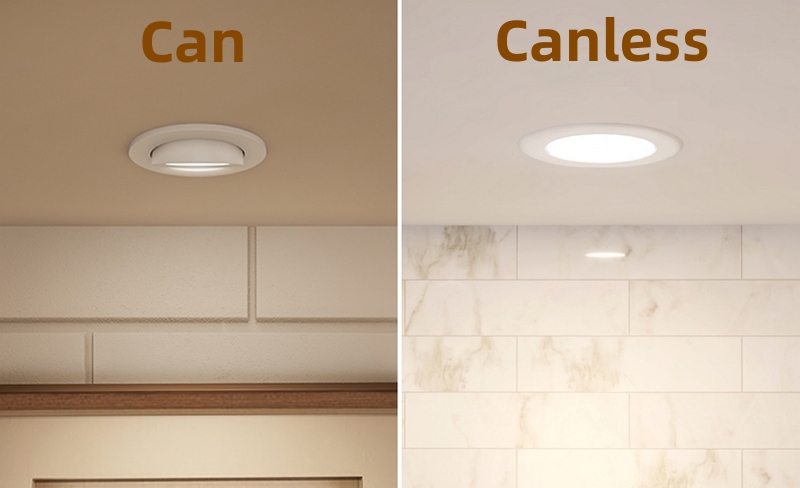Can Vs Canless Recessed Lighting
Can vs canless recessed lighting is a comparison of two different types of recessed lighting fixtures. Can lighting is installed in a traditional metal housing that is installed in the ceiling. Canless lighting, on the other hand, is installed directly into the ceiling without the need for a metal housing. Both types of lighting fixtures provide excellent lighting for any area, but they have some differences that need to be taken into consideration when choosing the right lighting for a specific space. Can lighting is often more expensive, and may require additional installation steps, while canless lighting is usually less expensive and easier to install. Can lighting can provide more directional light, while canless lighting is more diffuse, but both types of lighting fixtures can be used to provide a soft ambient light for any room.
What is Recessed Lighting?
Recessed lighting is a type of lighting fixture that is installed in a ceiling, wall, or floor, allowing for an even spread of light across a room. These lights are often used to provide ambient lighting, as they are designed to be unobtrusive. A canless recessed light is a type of recessed lighting that is installed without a large metal housing, or “can”. This type of lighting can be installed quickly and easily, and is becoming increasingly popular for both residential and commercial lighting projects.
Canless recessed lighting offers several advantages over traditional recessed lighting. Because the fixtures are smaller and do not require a large can, they are easier to install, often requiring fewer tools and less labor. Additionally, they can be installed in tighter spaces, providing more versatility. Canless recessed lighting fixtures are also often more energy-efficient, as they tend to use LED fixtures, which draw less electricity than traditional bulbs.
While canless recessed lighting is an excellent choice for many lighting projects, it is important to consider the specific needs of the space before making a decision. It is important to consider the size of the space, the amount of light needed, and the desired look and feel. Additionally, it is important to consider whether the project requires a more traditional look or a more modern aesthetic. By considering all of these factors, one can make an informed decision about the best type of recessed lighting for their project.
Benefits of Recessed Lighting
Recessed lighting offers homeowners a wide range of benefits, from energy efficiency to enhanced aesthetic appeal. Generally, recessed lighting fixtures are either “can” or “canless” designs. Can-style fixtures require a traditional housing, while canless fixtures do not. Each style of recessed lighting has its own advantages.
Can recessed lighting fixtures are the traditional style, with a housing that is installed into a ceiling. This housing holds the light bulb and the trim. These can-style fixtures are often more affordable than canless fixtures and provide a more secure fit.
Canless recessed lighting fixtures are an increasingly popular option. These fixtures do not require a traditional housing and provide a more streamlined aesthetic. Canless fixtures are usually more expensive than can-style fixtures, but they are also more energy efficient and provide better light output.
Both can and canless recessed lighting fixtures offer homeowners the opportunity to create a more aesthetically pleasing design, while also saving energy and money on their energy bills. With a wide variety of styles available, homeowners can find a recessed lighting option that suits their individual needs and preferences.
What is Canless Recessed Lighting?
Canless recessed lighting is a modern and efficient way to brighten up any space. It is a cost-effective and space-saving alternative to traditional recessed lighting fixtures, which require a “can” or a metal housing to contain the light bulb and other components. Canless recessed lighting, on the other hand, utilizes a sleek, slim design that is easy to install and requires less space.
Canless recessed lighting is made up of a slim, integrated housing and trim that eliminates the need for a bulky can or metal housing. This type of lighting is ideal for tight spaces, as the slim design allows for easy installation in narrow spaces. It also requires minimal wiring and is energy-efficient, making it an ideal choice for both residential and commercial applications.
Canless recessed lighting fixtures come in a variety of styles and finishes, allowing you to customize the look and feel of your space. From dimmable LED lights to adjustable styles, there are a variety of options to choose from. These fixtures are also available in various shapes and sizes, making it easy to find a fixture that fits your needs.
Canless recessed lighting is a great way to brighten up any space without the need for bulky fixtures. With its slim design, energy-efficiency, and variety of styles, it is an ideal choice for any application. Whether you are looking for a sleek and modern look or a more traditional look, canless recessed lighting has you covered.
Advantages of Canless Recessed Lighting
Canless recessed lighting has become a popular alternative for many homeowners due to its many advantages over traditional can lighting. Canless recessed lighting requires less energy to operate, it is easier to install, and it can be more aesthetically pleasing. Canless recessed lighting also has a longer lifespan than can lighting, which can be a great money-saving benefit in the long run.
When it comes to energy efficiency, canless recessed lighting is a clear winner. Unlike can lighting, canless recessed lighting does not require a can to contain the heat generated by the bulb, which allows it to be around 80% more efficient. This means that you can save money on your electricity bill while still having a bright, stylish lighting fixture in your home.
Installing canless recessed lighting is also much easier than installing can lighting. Canless recessed lighting is typically installed with just a few simple screws and does not require any additional wiring. This makes it an ideal option for DIYers who want to save time and money.
Additionally, canless recessed lighting can be more aesthetically pleasing than can lighting. Canless recessed lighting fixtures come in a variety of styles, sizes, and colors, giving you the flexibility to choose the perfect fixture to match your home’s decor.
Overall, canless recessed lighting provides many advantages over traditional can lighting. Its energy efficiency, easy installation, and attractive design make it an attractive option for many homeowners.

Disadvantages of Canless Recessed Lighting
Canless recessed lighting has become increasingly popular over the past few years and for good reason. It is easy to install, energy efficient, and cost effective. However, as with any lighting option, there are some disadvantages to consider.
One of the primary drawbacks of canless recessed lighting is that it may not be the best option for larger rooms. While the light produced is often good, it can be difficult to evenly distribute the light throughout a larger area. Also, since these lights don’t require a housing can, they are not as durable as traditional can-style recessed lighting. This means they may need to be replaced more frequently.
Another disadvantage of canless recessed lighting is that it can be difficult to replace bulbs. Since the bulbs are not enclosed in a housing can, you need to be careful when changing them out. This can be a bit tricky and time consuming. Additionally, since these lights are designed to be energy efficient, some may not be compatible with dimmer switches, limiting their versatility.
Finally, while canless recessed lighting can save you money on installation and energy costs, it can be more expensive to buy than traditional can-style recessed lighting. So, if you’re looking for an inexpensive solution, canless recessed lighting may not be the best option.
In conclusion, canless recessed lighting can be a great option for those looking for an easy install, energy efficient lighting solution. However, there are some drawbacks to consider, such as difficulty installing in larger areas, potential incompatibility with dimmer switches, and higher upfront costs. So, make sure to weigh the pros and cons before making your decision.
Comparison of Can and Canless Recessed Lighting
Recessed lighting is a popular choice among homeowners due to its versatility and ability to provide a clean, modern look. It is available in two main varieties: can and canless. While they both offer the same results, they have key differences that should be considered when making a purchase. To help you decide which type of recessed lighting is right for you, let’s compare can and canless recessed lighting.
Can recessed lighting, also known as pot lights, are traditional recessed lights that are installed in the ceiling with a metal housing. This type of lighting provides a warm, cozy feel and is easier to install. Canless recessed lighting, on the other hand, has no housing and is designed to fit directly into the ceiling. This type of lighting is more modern and can provide a higher level of illumination.
In terms of installation, can recessed lighting is generally easier to install than canless recessed lighting, as it requires less wiring. Canless recessed lighting, however, is more energy-efficient and can provide a brighter light. Additionally, canless lighting offers more flexibility in terms of placement and design, allowing for creative lighting solutions.
When it comes to cost, can recessed lighting tends to be more affordable than canless lighting, especially when installation costs are taken into consideration. However, canless recessed lighting can often be more cost-effective in the long run due to its energy-saving benefits.
Ultimately, the decision between can and canless recessed lighting comes down to personal preference. If you are looking for a more traditional look and an easier installation, can recessed lighting may be the way to go. If you are looking for an energy-efficient option with more flexibility and illumination, canless recessed lighting may be the better option.
Installation Considerations for Can and Canless Recessed Lighting
When installing recessed lighting, one of the biggest decisions homeowners must make is between can and canless recessed lighting. The two offer different benefits, but which one is right for your home? Understanding the differences between can and canless recessed lighting and the installation considerations that come with each can help you make the right choice for your home.
Can recessed lighting has been around for many years and is still a popular choice for many homeowners. It is encased in a metal cylinder, or can, and is easy to install with existing wiring. However, it can be difficult to replace bulbs and clean the fixtures, and it can be more expensive to install.
Canless recessed lighting is relatively new compared to can recessed lighting. It is often more cost-effective to install and is easier to clean and replace bulbs. However, it does require cutting into the ceiling, making it a more involved installation process.
When deciding between can and canless recessed lighting, you should consider the installation difficulty, cost, and maintenance requirements of each. If you’re looking for an easy installation process and low maintenance, canless recessed lighting may be the better option. If you’re looking for a more cost-effective option that can be installed with existing wiring, can recessed lighting may be a better choice. Ultimately, the decision is up to you.
Summary and Conclusions
When it comes to recessed lighting, homeowners are faced with a choice between cans and canless designs. Cans offer more control over the lighting output as they can be replaced or upgraded, whereas canless options are more permanent and provide a cleaner, more modern look. Ultimately, the choice between cans and canless recessed lighting comes down to personal preference and the specific needs of the space.
For spaces that require more versatility and control, cans are likely the best option. However, if a more modern look is desired and the lighting requirements are more static, canless recessed lighting is a great way to go. It is also important to consider the size of the space when making this decision, as larger spaces may require more lighting output than a canless option can provide.
No matter the choice, both cans and canless recessed lighting offer a great way to bring light to any space. Whether it’s for accenting a particular area, creating a more uniform lighting output, or just making a space more inviting, recessed lighting is a great option for any home. The key is to understand the differences between cans and canless designs and make an informed decision that best meets the needs of the space.
FAQs About the Can Vs Canless Recessed Lighting
Q1. What is the difference between can and canless recessed lighting?
A1. Can recessed lighting requires a dedicated housing and trim, while canless recessed lighting does not. Can recessed lighting is installed by cutting a hole in the ceiling and then attaching the housing to the joists. Canless recessed lighting is installed by simply pushing the trim and light into the ceiling.
Q2. Is canless recessed lighting cheaper than can recessed lighting?
A2. Canless recessed lighting is generally more cost-effective than can recessed lighting due to the fact that it does not require a dedicated housing and trim.
Q3. What type of light bulbs can be used in canless recessed lighting?
A3. Canless recessed lighting is designed to accept LED bulbs, halogen bulbs, and other energy-efficient bulbs.
Conclusion
In conclusion, can vs canless recessed lighting really comes down to personal preference. Can lighting is more traditional and can provide more light, while canless recessed lighting is more modern and requires no bulky can. It all depends on the look you are going for and the lighting you need. Ultimately, the choice is yours.






